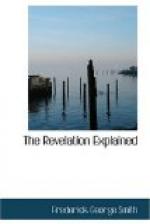In this vision John beheld a beast rise out of the sea. His appearance—like that of a leopard with the feet of a bear and a mouth like a lion—indicated that he was some terrible creature. He was also a persecutor of the saints, the same as the dragon that preceded him. As before explained, this beast, also, symbolizes the Roman empire; for he possesses the same heads and horns as the dragon, the only difference being that the supreme power and authority, as indicated by the crowns, is now vested in the ten horns, or minor kingdoms, instead of in the seven heads. The dragon as a political power represented Rome before her overthrow by the barbarians; the beast as a political power represents new Rome.
A careful study of the characteristics of this beast, however, will show that he represents more than a civil power. As a mere beast from the natural world he could symbolize nothing more than some political power; but it will be noticed that, combined with his beastly nature, there are also certain characteristics that belong exclusively to the department of human life—a mouth speaking great things; power to magnify himself against the God of heaven; the ability to single out the saints of God and kill them, and to set himself up as an object to be worshiped, etc. This combination of symbols from the two departments—those of animal and of human life—points us with absolute certainty to Rome as a politico-religious system. Ask any historian what world-wide power succeeded Rome Pagan, and he will answer at once, “Rome Papal.”
While it is not my general design to explain the many lines of prophetic truth described under similar symbols in other parts of the Bible, yet I will ask the reader here to pardon the slight digression while I call attention briefly to a few thoughts in the seventh chapter of Daniel regarding this same Papal power.
Daniel received a vision of four great beasts, which were interpreted to symbolize four universal monarchies. Verse 17. These were the Babylonian, the Medo-Persian, the Greco-Macedonian, and the Roman. The fourth beast possessed ten horns, which were explained to signify ten kingdoms to arise out of the fourth empire. This is identical with the dragon of Rev. 12, except the latter possessed seven heads not mentioned by Daniel. In the midst of the ten horns (ten minor kingdoms) grew up a little horn, which soon assumed greater proportions than his fellows, taking the place of three of the original horns, and into his hand the saints of the Most High were given for “a time and times and the dividing of time,” or twelve hundred and sixty years. This eleventh horn differed from the ten in that it possessed a mouth speaking great things, and the eyes of a man. A horn with eyes and mouth in it is a very unusual thing, yet it is just such a combination as we might expect when we possess a correct knowledge of symbols. Being drawn from two departments—human life and animal life—this double-symbol directs us to a politico-religious system that came up among the ten horns that grew out of the old Roman empire. We instantly identify it with the growing Papacy, which arose to a position of great authority in conjunction with the new Roman empire.




